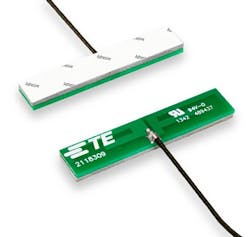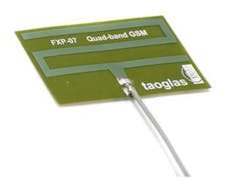Antennas are critical components for many wireless systems, with printed-circuit-board (PCB) antennas leading the pack due to their small size and ease of integration with other high-frequency circuits. The performance and consistency of a PCB antenna depends heavily on the quality of its foundation circuit laminate, with size very much a function of the target frequency and wavelength of the antenna.
There’s no doubt a voracious appetite for wireless applications—from personal communications systems (PCS) to Internet of Things (IoT) apps, to automotive electronic control and safety systems. And as operating frequencies creep higher, from the 2.4-GHz band of PCS applications to the millimeter-wave (mmWave) frequencies of automotive advanced driver-assistance systems (ADAS), the needs for antennas accompanies them. That’s where PCB antennas step in—designers often turn to them as practical solutions to handle the ever-growing array of wireless applications.
High-frequency PCB antennas can be as simple as a microstrip patch fabricated on one side of a circuit laminate with a slightly larger ground plane underneath it, on the other side of a dielectric layer. The low profile of such antennas makes them attractive for mounting within systems that have any available flat surface.
Of course, the antenna radiation pattern from such a simple microstrip patch will be limited. PCB antennas working with microstrip patches often combine several patches on one PCB to achieve higher gain for a given operating frequency. The size the patch will depend on the wavelength of the target operating frequency, with one-half wavelength typically selected to optimum resonant antenna characteristics at the target frequency.
Certainly, RF/microwave PCB antennas can be fabricated with many different transmission-line technologies, such as stripline and coplanar-waveguide transmission lines. They may even combine several different transmission lines within the same PCB antenna design.
What’s Out There?
PCB antennas are available from many suppliers as fabricated components that can be added to a system design; several manufacturers also offer services to construct PCB antennas according to computer-aided-engineering (CAE) design files or custom mechanical requirements. For example, Advanced Circuitry International (ACI) can manufacture large antennas (for lower frequencies) or large volumes of smaller antennas on large circuit boards, such as 12 × 18 in. and 18 × 24 in., using single-sided, double-sided, and multilayer PCB antenna configurations (Fig. 1).
1. Some manufacturers offer extended capabilities for fabricating PCB antennas on a wide range of circuit materials and according to a customer’s precise requirements. (Courtesy of Advanced Circuitry International)
ACI fabricates antennas on a variety of different substrate materials, including high-performance flexible circuit materials from DuPont as well as RF/microwave circuit laminates from leading circuit material suppliers such as Arlon, Isola, Rogers Corp., and Taconics.
The PCB antennas are often supplied with an adhesive to simplify mounting within an intended application. Choosing such a circuit material as the foundation for a PCB antenna is critical to its short- and long-term performance , especially as PCB antennas are being used at higher mmWave frequencies and in more hostile operating environments (e.g., ADAS applications).
General Assemblies
In some cases, PCB antennas are supplied as “assemblies,” complete with a connected coaxial cable and connector for quick and easy interconnections to an internal circuit board. One such PCB antenna supplier, TE Connectivity, has developed an extensive line of PCB antennas with cables and connectors to accommodate a wide range of frequency bands for personal communications systems applications.
Specifically, there’s the company’s Model 2118060-1 PCB antenna assembly (Fig. 2). It can be supplied for operating frequencies from approximately 2.4 to 2.5 GHz for Bluetooth, Wi-Fi, and wireless local-area networks (WLANs). The cable is 13.78 in. (350 mm) in length, with choice of different types of connectors, such as MCIS and MHF connectors; the PCB antenna includes adhesive for mounting on a flat surface.
2. This PCB antenna is considered an assembly, with interconnecting cable and connector and adhesive for ease of integration and mounting in different applications. The antenna assembly (model 2118060-1) is designed for use from 2.4 to 2.5 GHz. (Courtesy of TE Connectivity)
Similarly, the model FXP07.07.0100A from Taoglas Antenna Solutions is a low-profile flexible PCB antenna with short length of cable and IPEX connector and adhesive tape to facilitate stick-on mounting on flat surfaces (Fig. 3). The RoHS-compliant antenna is designed for use with “Penta-band” frequencies, which include AMPS from 824 to 896 MHz, GSM from 880 to 960 MHz, DCS from 1710 to 1880 MHz, PCS from 1850 to 1990 MHz, and UMTS from 1710 to 2170 MHz. The compact 50-Ω antenna measures 41 × 24 mm with linear polarization and an omnidirectional radiation pattern.
3. This low-profile PCB antenna assembly can support a wide range of frequencies covering a total range of 824 through 2170 MHz. (Courtesy of Taoglas Antenna Solutions)
A growing trend in the design of PCB antennas is multiple-frequency-band coverage to accommodate systems with wideband frequency ranges and/or multiple applications. For instance, the CW3315B0100 line of flexible PCB antennas from Pulse Electronics features dual-band Wi-Fi antennas designed to cover the WLAN frequency bands of both 2.4 to 2.5 GHz and 4.90 to 5.85 GHz (Fig. 4).
4. This miniature flexible PCB antenna assembly is designed to cover the WLAN frequency bands of both 2.4 to 2.5 GHz and 4.90 to 5.85 GHz. (Courtesy of Pulse Electronics)
These are also PCB antenna assemblies, with 100-mm cables and standard IPEX connector for ease of connection to an application. The miniature antenna assemblies, which offer high efficiency of better than 50%, are designed for internal mounting in Wi-Fi products. The CW3315B0100’s dual-band/wideband coverage represents a practical antenna solution for industrial applications and IoT devices as well as applications in Public Safety devices.
The ease of mounting such miniature PCB antennas using adhesives may at times result in the absence of a ground plane of any kind, which reduces efficiency. While the underside of a PCB antenna laminate is typically a ground plane, the larger ground planes required for higher efficiency can add to the physical size of a PCB antenna and must be considered when mounting the antenna in an application.





